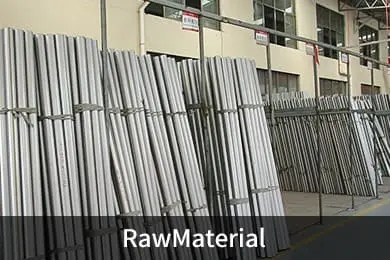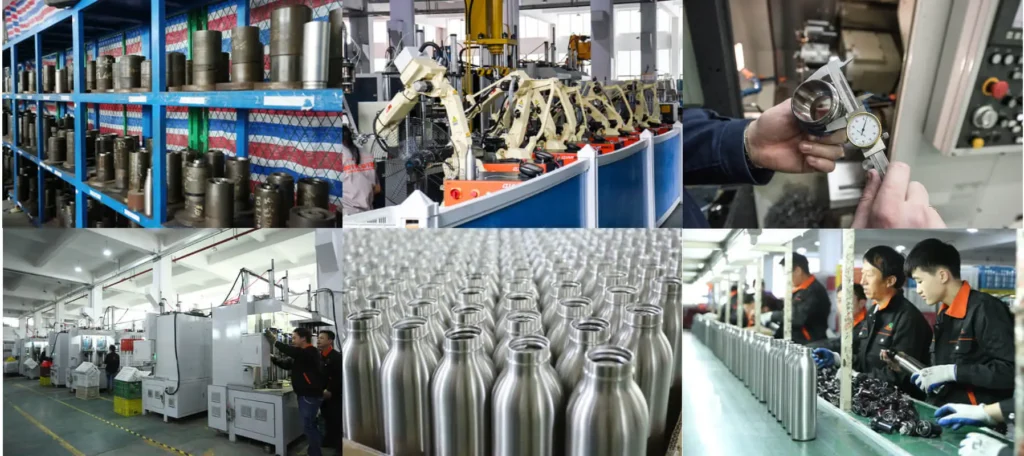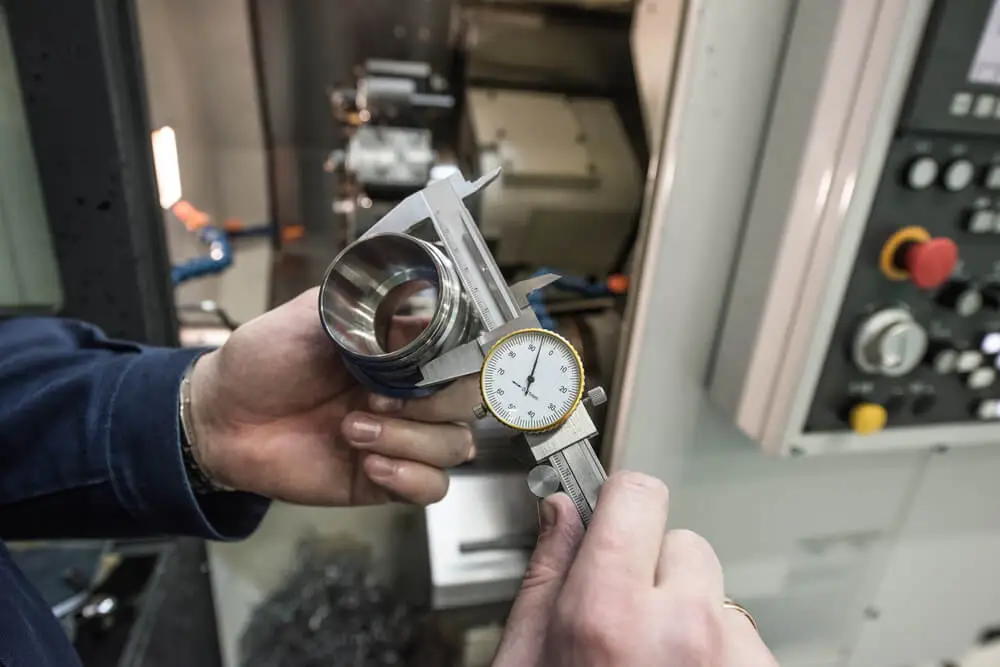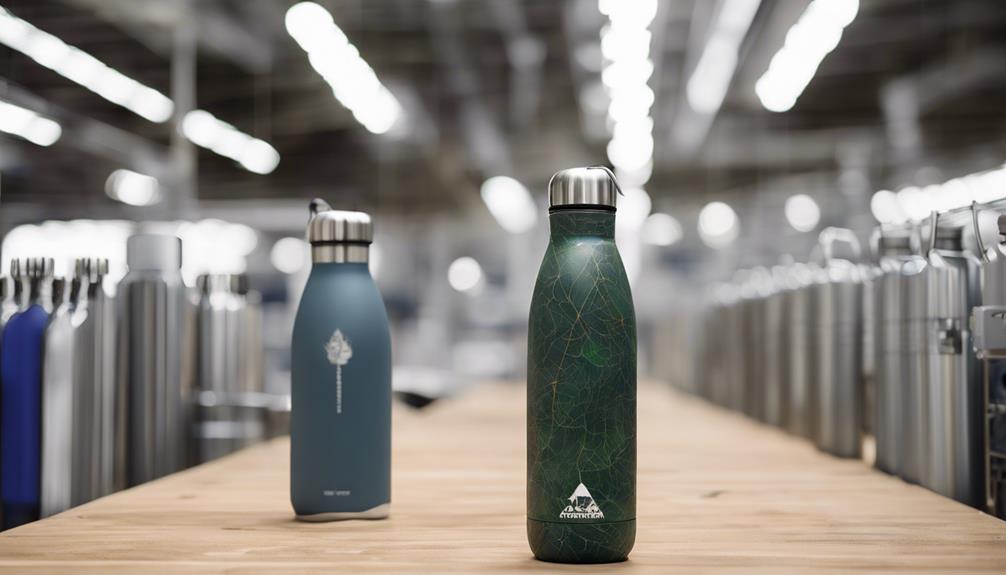In the intricate supply chain of stainless steel water bottle manufacturing, you must focus on sourcing high-quality raw materials and incorporating advanced production techniques for eco-conscious products. Implement stringent quality control measures, promptly resolving any defects to maintain product integrity. Enhance branding elements with consistent messaging and informative labeling for consumer trust. Sustainability should be highlighted to attract environmentally conscious buyers. Efficient distribution networks and staying informed about industry trends are crucial for competitive positioning. These strategies ensure high-quality, sustainable products that meet consumer demands and industry standards.
Sourcing Raw Materials

To manufacture stainless steel water bottles efficiently, begin by strategically sourcing high-quality raw materials from reputable suppliers. When selecting material suppliers, conduct a thorough pricing analysis to ensure competitive rates without compromising quality. Consider the environmental impact of the materials by opting for suppliers who prioritize sustainability and eco-friendly practices. Ethical sourcing is also crucial, so choose suppliers who adhere to fair labor practices and ethical standards in their operations.
Research various material suppliers to compare pricing, quality, and sustainability practices. Look for suppliers that offer certifications or documentation to support their ethical and environmental claims.
Establishing strong relationships with reliable suppliers won't only ensure a steady flow of quality materials but also contribute to building a sustainable and responsible supply chain for your stainless steel water bottle manufacturing process.
Manufacturing Processes

When it comes to manufacturing stainless steel water bottles, your focus should be on the raw material sourcing, production techniques, and quality control measures.
Understanding where the materials come from, utilizing efficient production methods, and implementing rigorous quality checks are key factors in creating a durable and high-quality product.
Raw Material Sourcing
How are the raw materials for stainless steel water bottle manufacturing carefully selected to ensure high quality and durability in the production process?
The process begins with a focus on sustainable sourcing and ethical practices. Manufacturers prioritize partnering with suppliers who adhere to responsible mining practices to minimize environmental impact. By sourcing materials ethically, the supply chain ensures that the production of stainless steel water bottles aligns with social and environmental standards.
In addition to ethical considerations, manufacturers also explore cost-effective alternatives through global partnerships. Collaborating with suppliers from different regions allows for a diverse range of options when acquiring raw materials. By leveraging global partnerships, manufacturers can access high-quality materials at competitive prices, ultimately benefiting the production process and end product.
Production Techniques
In the manufacturing of stainless steel water bottles, the production techniques encompass a series of meticulously designed processes that ensure precision and efficiency in crafting durable and high-quality products. Design innovations play a crucial role in meeting evolving market demand for sleek, functional, and eco-friendly water bottles. Manufacturers employ advanced technologies like hydroforming and deep drawing to create intricate shapes and designs that cater to consumer preferences while maintaining the bottles' structural integrity.
Considering the environmental impact, many production facilities have adopted sustainable practices such as using recycled stainless steel and implementing energy-efficient manufacturing processes. These efforts align with the growing consumer preference for eco-conscious products.
Additionally, cost efficiency remains a core focus in production techniques, with manufacturers continually seeking ways to streamline operations, reduce waste, and optimize resource utilization without compromising product quality.
Quality Control Measures

Implementing stringent quality control measures throughout the manufacturing processes is imperative to ensure the consistency and excellence of stainless steel water bottle production. Performance testing is a crucial step to guarantee that each bottle meets the highest standards. By conducting rigorous tests on factors like leak resistance, insulation efficiency, and overall durability, manufacturers can identify and rectify any potential issues before the final product reaches the consumer.
Durability standards play a significant role in maintaining the integrity of stainless steel water bottles. These standards encompass factors such as structural strength, corrosion resistance, and overall lifespan of the product. By adhering to strict durability guidelines, manufacturers can ensure that their bottles withstand daily use and maintain their quality over time.
Compliance regulations and material certifications are also essential aspects of quality control in stainless steel water bottle manufacturing. Ensuring that all materials used meet industry standards and that production processes comply with regulations not only guarantees the safety and quality of the final product but also builds trust with consumers. By incorporating these measures into the manufacturing processes, manufacturers can establish a reputation for producing reliable and high-quality stainless steel water bottles.
Quality Control Measures
When it comes to ensuring the quality of stainless steel water bottles, you need to focus on two critical points: inspection procedures and defect resolution processes.
By implementing thorough inspection procedures throughout the manufacturing process, you can catch any potential issues early on.
Additionally, having efficient defect resolution processes in place is essential to address and rectify any quality concerns swiftly and effectively.
Inspection Procedures

To ensure the highest quality standards are met, rigorous inspection procedures are implemented throughout the manufacturing process of stainless steel water bottles. Product testing plays a crucial role in verifying the durability and safety of the bottles. Certification processes are followed to ensure that the materials used meet industry standards and regulatory requirements. Supplier audits are conducted regularly to assess the quality of raw materials and components sourced for the manufacturing process. Compliance standards are strictly adhered to during each phase of production to guarantee that the final product meets customer expectations.
During the inspection procedures, various tests are conducted to check for leaks, structural integrity, and overall product quality. Visual inspections are carried out to detect any defects or imperfections in the stainless steel water bottles. Additionally, pressure tests are performed to assess the bottle's resistance to external forces.
Defect Resolution Processes
Quality control measures for defect resolution processes in stainless steel water bottle manufacturing aim to identify and rectify any imperfections or issues that may compromise the product's integrity. By implementing stringent quality improvement protocols, manufacturers can ensure that each stainless steel water bottle meets the highest standards before reaching the customer.
In the defect resolution process, it's crucial to address any issues promptly to enhance customer satisfaction and maintain a positive brand reputation.
To achieve optimal quality control, manufacturers utilize advanced technologies such as automated inspection systems and quality assurance teams to detect and resolve defects efficiently. By continuously analyzing and improving defect resolution processes, companies can enhance product quality and meet customer expectations consistently.
Timely defect resolution not only ensures product reliability but also plays a vital role in enhancing customer satisfaction levels.
Ultimately, a robust defect resolution process is essential for maintaining high-quality standards, improving overall product quality, and ensuring customer satisfaction in the competitive stainless steel water bottle manufacturing industry.
Packaging and Labeling

Consider incorporating branding elements on the packaging and labels to enhance the overall presentation of the stainless steel water bottles. By strategically designing the packaging and labels, you can effectively communicate your branding strategies and further strengthen your market positioning.
Here are three key aspects to focus on:
- Branding Elements: Ensure that the packaging and labels prominently feature your logo, brand colors, and any unique brand identifiers. Consistent branding across all touchpoints reinforces brand recognition and loyalty.
- Product Information: Include essential product information on the labels such as capacity, material composition, care instructions, and any certifications or standards met. Transparent and accurate information builds trust with customers.
- Sustainability Messaging: Highlight any eco-friendly aspects of your product, such as being BPA-free, reusable, or recyclable. In today's market, consumers appreciate sustainable choices and showcasing this on your packaging can attract environmentally conscious buyers.
Careful attention to these details in packaging and labeling can significantly impact consumer perception and drive sales.
Distribution Networks

Efficient distribution networks play a pivotal role in ensuring timely delivery and widespread availability of stainless steel water bottles in the market. To achieve this, meticulous logistics management is essential to streamline the movement of products from manufacturing facilities to distribution centers and eventually to retailers or consumers. Transportation efficiency plays a crucial role in meeting delivery timelines and reducing costs associated with shipping.
Table: Factors Impacting Distribution Networks
| Factors | Description | Importance |
|---|---|---|
| Inventory Optimization | Balancing stock levels to meet demand | High |
| Demand Forecasting | Predicting future sales trends | Critical |
| Logistics Management | Coordinating the flow of goods | Essential |
Inventory optimization ensures that there are enough stainless steel water bottles available to meet consumer demand without overstocking or understocking. Demand forecasting helps in anticipating market trends, enabling manufacturers to adjust production levels accordingly. Effective logistics management ensures the smooth coordination of transportation and distribution activities, enhancing overall supply chain efficiency.
Sustainability Initiatives

To effectively integrate sustainability initiatives into the manufacturing process of stainless steel water bottles, it's imperative to prioritize eco-friendly materials and production methods. By focusing on reducing the carbon footprint and implementing recycling programs, the industry can make significant strides towards environmental conservation and responsible manufacturing practices.
Recycling Programs:
Implementing comprehensive recycling programs within the manufacturing facilities can help minimize waste generation and encourage the reuse of materials, reducing the overall environmental impact of production processes.
Carbon Footprint Reduction:
Utilizing energy-efficient technologies and renewable energy sources can significantly lower the carbon footprint associated with manufacturing stainless steel water bottles, contributing to a more sustainable production cycle.
Sustainable Sourcing:
Opting for materials sourced from responsibly managed suppliers who adhere to sustainable practices ensures that the production chain maintains ecological integrity and supports ethical sourcing standards.
Industry Trends
To stay competitive in the stainless steel water bottle manufacturing industry, staying abreast of emerging industry trends is vital for navigating the evolving market landscape effectively. Keeping an eye on market demand and consumer preferences can significantly impact product design decisions. Understanding the latest material innovations can also give your company a competitive edge in the market.
| Industry Trends | Impact on Manufacturing |
|---|---|
| Market Demand | Understanding consumer needs and adjusting production |
| Product Design | Incorporating trend-setting features for consumer appeal |
| Material Innovations | Adopting new materials for enhanced product performance |
Frequently Asked Questions
What Are the Typical Challenges Faced in Stainless Steel Water Bottle Manufacturing?
In stainless steel water bottle manufacturing, challenges often revolve around quality control and production efficiency. Ensuring consistent quality standards while optimizing production processes can be demanding but crucial for success in this industry.
How Does the Industry Ensure Ethical Labor Practices Throughout the Supply Chain?
To ensure ethical labor practices in the industry, focus on fair worker rights and compliance. Transparency in the supply chain is key. Verify that all stakeholders adhere to standards, promoting a culture of responsibility and accountability.
Are There Any Regulations Specific to Stainless Steel Water Bottle Production?
To ensure regulatory compliance in stainless steel water bottle production, you must adhere to specific regulations governing materials, manufacturing processes, and safety standards. Environmental impact must be a key consideration, with an emphasis on sustainability and waste reduction.
What Innovations Are Being Explored to Enhance Product Durability?
In material research, experts explore advanced alloys to boost impact resistance. Innovations like streamlined designs and reinforced components enhance product longevity. Embrace these developments to elevate durability, ensuring your stainless steel water bottles stand the test of time.
How Do Manufacturers Address Consumer Concerns About Chemical Leaching in Bottles?
Imagine you're a manufacturer prioritizing consumer safety. To address concerns about chemical leaching in bottles, rigorous chemical testing is essential. By ensuring materials meet stringent safety standards, you can build trust and confidence with your customers.
Conclusion
In conclusion, the supply chain of stainless steel water bottle manufacturing involves sourcing raw materials, manufacturing processes, quality control measures, packaging and labeling, distribution networks, sustainability initiatives, and industry trends.
For example, a stainless steel water bottle company may source stainless steel from a trusted supplier, utilize advanced manufacturing techniques to ensure durability, implement strict quality control measures to maintain product standards, and partner with eco-friendly packaging suppliers to reduce environmental impact.
This comprehensive supply chain approach ensures high-quality products reach consumers efficiently.

